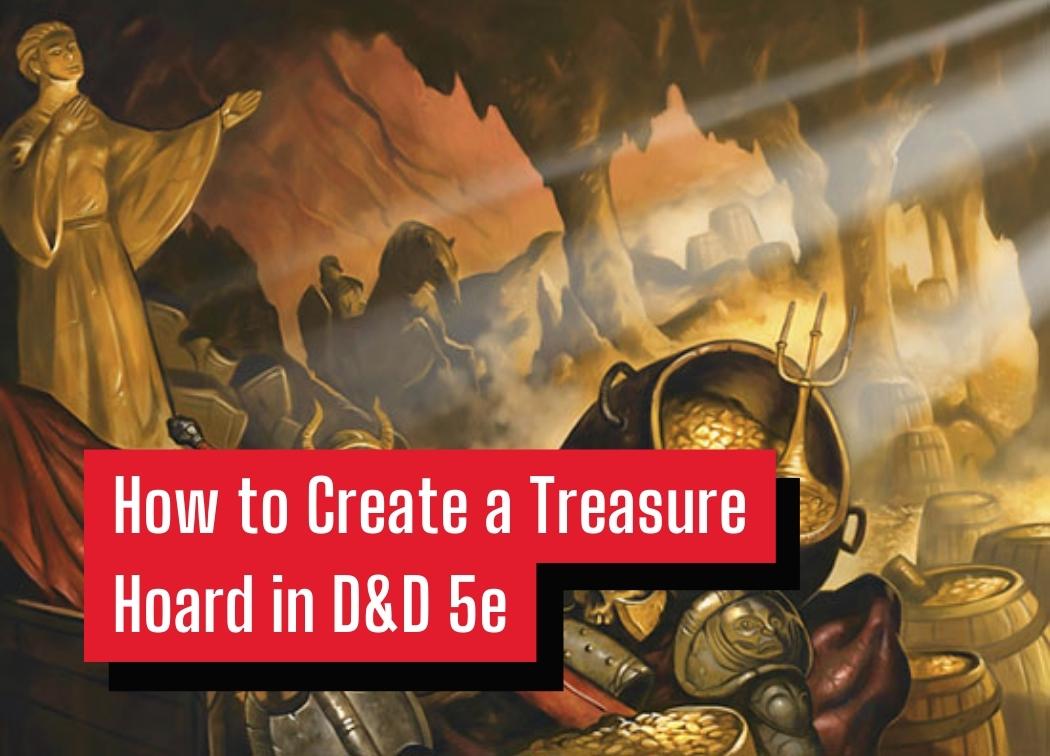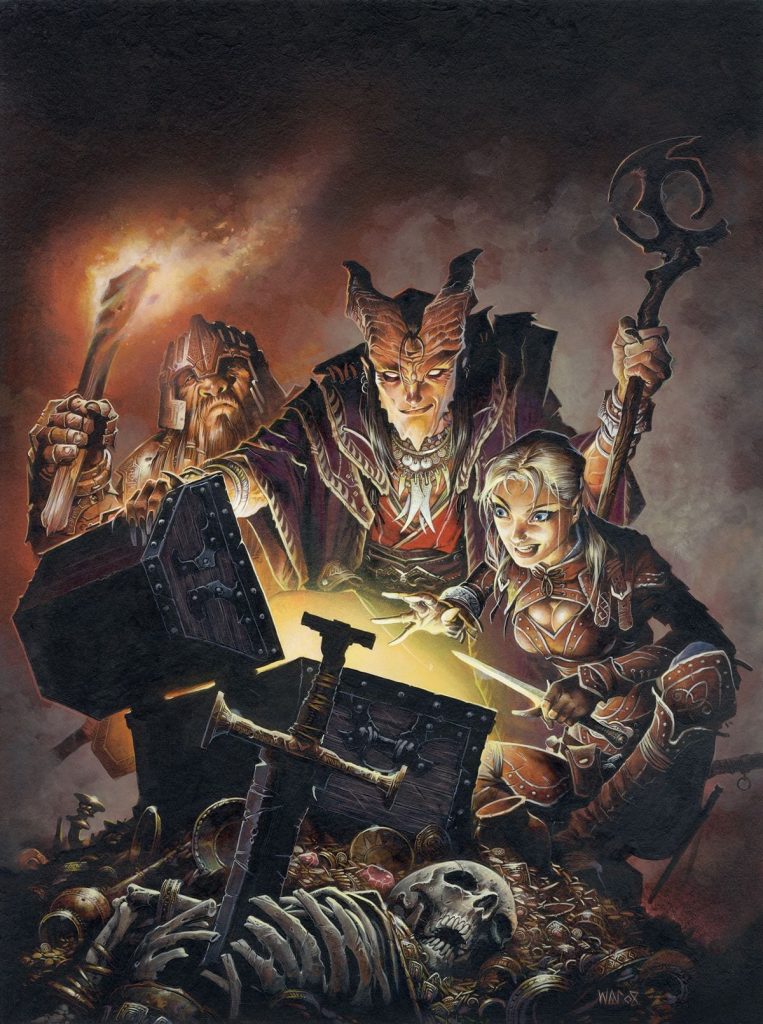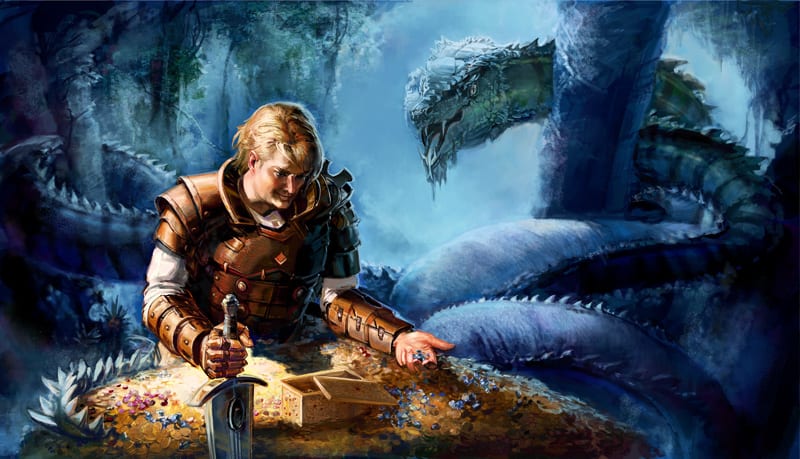How to Create a Treasure Hoard in D&D 5e

Treasure and leveling-up are the two rewards that players get outside of just enjoying the game. Treasure is important, and honestly, it can be pretty difficult to come up with treasure hoards and random rewards for players.
Between the Dungeon Master’s Guide (DMG) and Xanathar’s Guide to Everything (XGtE) there are tons of magical items and treasure suggestions. Throw in homebrew items and suggestions and you have so many options to choose from when you go to pick rewards and treasure. Choices are always a blessing and a curse.
Another factor that can make generating treasure and rewards difficult is knowing how much is appropriate. Giving too much treasure be it gold or magical items can derail a campaign pretty quickly depending on what is given out.
Creating a Treasure Hoard
In the DMG there is an entire chapter on treasure. I highly suggest reading through that chapter at some point, but it also has quite a few tables for you to use. These tables can be used to randomly create treasure hoards and rewards, or they can be used to gather ideas for treasure and rewards.
Mechanically you’re simply determining how much gold the players earn for completing the objective. Treasure in D&D scales with difficulty. Harder dungeons and quests will award more treasure just like how they’d award more experience points.

That being said, simply giving out gold every time would get very boring, very quickly even though it’s easier for you as the DM. Instead, you’ll want to spice things up. Give out gems, artifacts, and equipment that could be sold for gold or used by the party.
Another thing you’ll want to determine is the theme. A dragon’s treasure hoard is very different from the treasure chest you’d find in a pirate ship for example. Both the creature that owns the treasure and the location could determine what types of prizes the party will find in their adventure.
Magical Items
Then there’s magical items. Everyone’s favorite reward. In 5e, magical items are a bit more scarce compared to previous editions. I’ve gone over distributing magical items in a much earlier post, but they’re a big part of treasure in D&D 5e so I think they deserve another look-through in this post as well.
One of my favorite parts of XGtE has to be its many different tables. As you can imagine it has plenty for magical items; their creation, how to sell them, and of course, how many an adventuring party should have.
You can find a table for magical items awarded by rarity on page 135 of XGtE. The table also separates magical items by minor and major magical items.
Think of major magical items as those that require attunement and are very powerful like magical armor and weapons. Players won’t get many during a campaign, but when they do they’ll be important and extremely powerful.
Minor magical items are given out pretty frequently though. These are things like consumable potions and spell scrolls. They are still powerful and meaningful rewards, but they won’t affect the game nearly as much as a magical weapon or armor. A lot of the times these items also have a limited number of uses.
I personally haven’t used the table for a campaign yet as the book came out well after my long-term campaign started. However, the amount of magical items suggested for an adventuring party to get from level 1-20 is pretty generous. Everyone gets a fair number of major items and a plethora of minor items.
Picking out Magical Items
The DM can personally determine what magical items are found where just like with any other piece of treasure. They can also use generators or tables to randomly decide what items are found.
Most of the time I like to hand-pick what items are handed out when. I determine this based off of what character needs an upgrade and what the players might find fun. Once the party finds the items they can distribute them as they like, but I’d say 90% of the time the item I intended for a character goes to that character anyways.
Sometimes though I can’t really decide, or I’ve given out a few major items lately so no one has an immediate need for a new one. I’ll instead write “3 uncommon minor items” or something of that nature and have the players roll on one of the tables in the DMG for those items.
Another thing I like to do at the beginning of the game or at session 0 is to ask the players what items they might like to find. These could be crowd-favorites like the Bag of Holding or something that would work really well with their character.
You can then scatter these items throughout your world and give them to the party as it becomes appropriate. They get what they want, and it’s less of a decision for me. I call that a win-win!
How to Create a Treasure Hoard
I’d say that most of the time I end up determining my treasure hoards, rewards, and other types of loot ahead of time. I like to personalize everything and make sure that it makes both thematic sense as well as it being mechanically fair.
I also like to vary what types of treasure I give out. Sometimes I give out a lot of gold, sometimes I give out no gold but a few magic items. Plenty of times I give out a bit of everything. This can make creating treasure difficult depending on what I’m feeling like giving out as a reward.
The main thing to keep in mind when choosing treasure is what type of reward you’re creating. Basically, is it individual treasure or a treasure hoard. There are convenient tables and examples for both of these in the DMG, but they can make a big difference when designing your reward.
Personally, I still use different tools to help generate tools and ensure that my treasure hoards are both fun and balanced. These can help either off-set some of the pressure of generating treasure or just give me a base-line to work off of.
Use Tables
Tables are always great because they can be used as two completely different tools.
The first tool is a treasure generator. You can roll a die and take the result as part of (or all of) the treasure that comes as a reward. You can use multiple tables or roll many times on the same table to generate a treasure hoard.
The second tool is to use the table as an idea generator. Many different types of treasure and possibilities are listed on tables. Pick out what you like, or figure out a different choice that’s of a similar value.
These tables work as a baseline for balancing out an appropriate amount of treasure. Even if you make your own treasure piles and hoards from scratch you should consider double-checking them using the tables in the official sourcebooks and ones from reputable homebrewers.

Use an Online Treasure Generator
I love generators. They can be something that comes in handy when something unexpected happens. Go over to google and type in “D&D 5e treasure generator” and you’ll find a laundry list of online generators.
Most of these generators will ask you for either your party level and party size, or the CR of the encounter the reward is for. The program will then spit out one or more options for you to throw into the game.
Personally, I like to use Donjon’s 5e Treasure Generator as a baseline for creating treasure hoards. It’s pretty well-balanced to use as-is, but I like to personalize my treasure a bit more. Treasure hoards can change based on where the party finds it or who was the previous owner of the hoard.
That being said, you don’t have to use the generated treasure. Just like with tables you can use the output as a baseline and personalize the treasure to fit your game.
Conclusions
Everyone loves treasure in D&D. As the DM you get to act like Santa Claus giving out gifts, and as a player, you earn a reward and potentially have some great magical items to try out on your next adventure.
I tend to lean on tables and online generators to help me with creating loot and treasure hoards. These can help with the writer’s block aspect of creation or can come in handy for building a reward on the fly.
5e is a fairly low-magic edition compared to some previous iterations of D&D 5e. However, you can still include quite a few magic items in a traditional 5e game. Figure out how many items should be thrown into your world and include them as treasure too.
Treasure should be both fun and rewarding for the players. It should also not break your game. Figure out a good balance and have fun with it!
